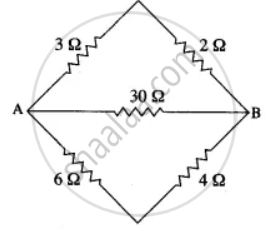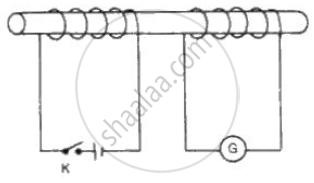Advertisements
Advertisements
Question
A cell supplies a current of 1.2 A through two 2 Ω resistors connected in parallel. When the resistors are connected in series, it supplies a current of 0.4 A. Calculate: (i) the internal resistance and (ii) e.m.f. of the cell.
Solution
In parallel R = ½ + ½ = 1 ohm
I = 1.2 A
ε = I(R + r) = 1.2(1 + r) = 1.2 + 1.2 r
In series R = 2+2 = 4 ohm
I = 0.4 A
ε = I(R + r) = 0.4(4 + r) = 1.6 + 0.4 r
It means :
1.2 + 1.2 r = 1.6 + 0.4 r
0.8 r = 0.4
r = 0.4 / 0.8 = ½ = 0.5 ohm
(i) Internal resistance r = 0.5 ohm
(ii) ε = I(R+r) = 1.2(1+0.5) = 1.8 V
APPEARS IN
RELATED QUESTIONS
What is the current in a circuit if the charge passing each point is 20 C in 40 s?
A flash of lighting carries 10 C of charge which flows for 0.01 s. What is the current? If the voltage is 10 MV, what is the energy?
Calculate the equivalent resistance between A and B in the adjacent diagram.

Tick(✓) the correct choice in the following:
When the length of a conductor is doubled the resistance of the conductor
will
The circuit diagram in fig shows two coils of an insulated copper wire wound on a cardboard tube. G is a center zero galvanometer.

(a) Describe what will happen when th e swi tch K is cl osed for severa l
seconds and then opened again .
(b) What will be the effect of repeating the experiment with an iron placed in the tube?
Explain, why the potential difference across the terminals of a cell is more when the cell is not in use than it is when the cell is being used.
State the condition when it is advantageous to connect cells in parallel.
Problems for practice:
If 5A current flows through a circuit, then convert the current in terms of microampere?
An ammeter is always placed in parallel with the circuit.
